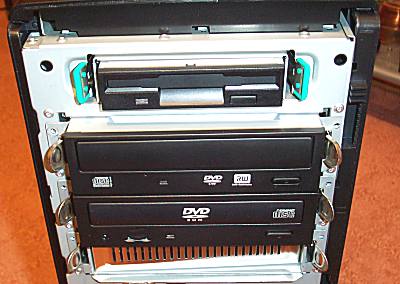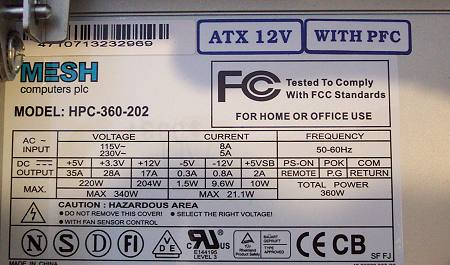MESH Inspection II
The system arrived in three boxes; one for the main PC tower and software, a second for the lovely 18.1" Viewsonic VP181b TFT, and a third for the large speaker set. Standard mainland delivery is £39 + VAT (£45.83). That's in line with the rest of the major system integrators, but as a consumer, that does seem to be on the steep side. It's almost as if the firms have an unspoken agreement to subsidise system prices with high delivery costs. Dell, however, charges no less than £49 + VAT to deliver a laptop from its factory outlet. There's little the consumer can do other than lament the pricing.The midi tower was well packaged inside the main box. Two large polystyrene sides held it firmly in place. A further smaller box held the software, fold-out sheet that acts as a quick start guide, and various power cables, etc. The guide appears to gloss over every model in MESH's range, but it does provide elementary information on ports, sockets and their respective uses. The flip side acts as a basic troubleshooting reference.

The first review picture shows MESH's stylish black case. A case's primary role is to hold components in place. Any budget case can fulfill that duty. A decent case, however, helps in circulating airflow correctly, allows for easy access to components, provides enough space to upgrade if and when the user chooses, and should be solid in construction. Each of those desirable attributes applies to this housing. MESH decides to locate the floppy drive at the highest level. This helps in two ways. Firstly, it makes it easier to use floppy discs; the tower is at the correct height. Secondly, and this is what MESH has done, it allows the hard drives to be mounted in a sideways fashion lower down the chassis.
The optical drives, with the DVD-ReWriter at the top, match the chassis' cover exactly, and there's still room for another drive just below. Unlike the Time system, there's no mutli-format card reader present. MESH could have added one into the spare 5.25" bay, and its omission is rather odd in an otherwise decent front. A rheobus, too, would have made the front that much more useful. MESH does add a couple of front-mounted USB 2.0 ports, located right next to the power button and activity LEDs.

Like most decent cases this one is tool-less and lockable. A simple twist of the lock (top-right) stops unauthorised access. A twist the other way and the side can be removed via a small handle that's a part of the side panel. Cooling is always a concern now. The sheer amount of wattage eaten up by graphics cards and CPUs is becoming a problem that will only be solved with smarter design. MESH has included ventilation provision for a 120mm fan, which is centre-right in the above shot. Being an all-steel chassis and housing an array of components, the E-JOY isn't the lightest of systems. It tips the scales at around 15kg. Portable it isn't.

The front facade is removed by two holding clips located on the same side as the lockable panel. You can see the quick-release mechanisms built around the floppy and optical drives. Another good idea.

Rounded cables for the optical and floppy drives. Incidentally, both optical drives are connected to a single cable. The the secondary IDE port is left unused. Just for the sake of elegance, each drive should have its own cable. SATA cabling carries on the silver theme. Strangely, though, MESH has seen fit to not use the VIA K8T800's on-chip SATA controller; both ports are left bare. Instead, the discrete PCI-riding Promise PDC20378 is used. It also supports a single ATA port. As you can see, the side-mounted hard drives are removable and the holder has space for another drive, which is nice.
The ASUS K8V Deluxe has 5 PCI slots. MESH takes up 3 and another is rendered almost unusable by the graphics card's cooler. A GAME port takes up slot #5, the Creative Audigy2 ZS and modem eat up slots 3 and 4. Amongst other features, the K8V Deluxe has Gigabit LAN from 3COM and 2-port FireWire from VIA's controller. The I/O section and a separate PCI plate makes sure every feature is used. The large 120mm fan is used to exhaust heat out of the case. We were free to navigate around the BIOS, and could manually change key performance parameters. Benchmarking, though, was left to those that it shipped with.

The PSU provides a reasonable 360w in total. 17A on the 12v line is enough to power what's required but then doesn't leave a whole lot of headroom for future expansion. MESH uses a few molex extenders and doublers to leave at least 2 standard molex power plugs and a floppy-style plug spare. The motherboard section is kept clear by having the excess power cabling wrapped up next to the PSU. A decent enough layout and installation on the whole. DIMM, drive, and component access is subjectively good. Nothing creaks or rattles and internal cooling has been thought out.









